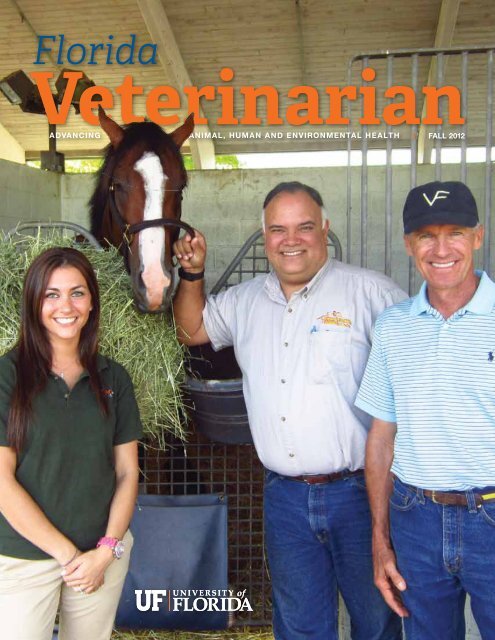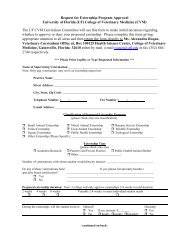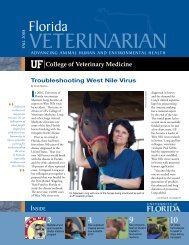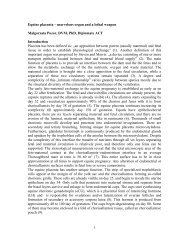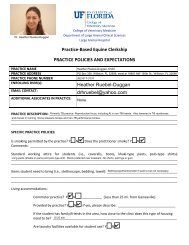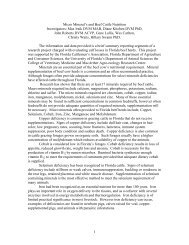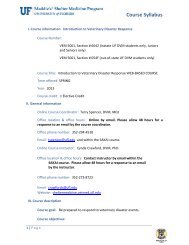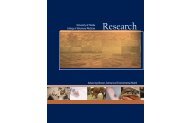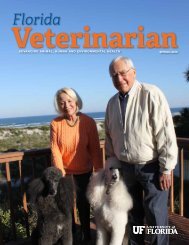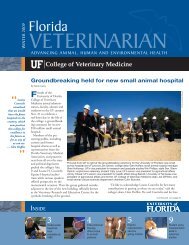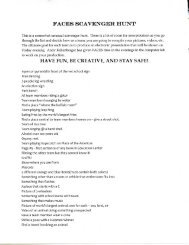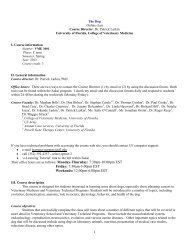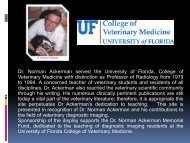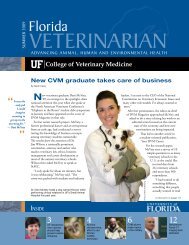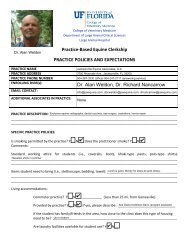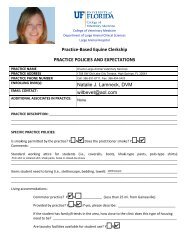Florida Veterinarian, Fall 2012 - University of Florida College of ...
Florida Veterinarian, Fall 2012 - University of Florida College of ...
Florida Veterinarian, Fall 2012 - University of Florida College of ...
Create successful ePaper yourself
Turn your PDF publications into a flip-book with our unique Google optimized e-Paper software.
<strong>Florida</strong><br />
<strong>Veterinarian</strong><br />
Advancing Animal, Human and Environmental Health |<br />
fall <strong>2012</strong>
Inside<br />
Message from the Dean<br />
Launching our Curriculum Review<br />
4Equine<br />
Clerkship<br />
7Grevior Shelter<br />
Medicine Suite<br />
8Mutant Gut<br />
Bacteria<br />
13<br />
New Pet Emergency<br />
Clinic in Ocala<br />
The UF <strong>College</strong> <strong>of</strong> Veterinary Medicine’s D.V.M. program<br />
curriculum has not had an extensive review for about 15<br />
years. The existing curriculum has served the college<br />
and our graduates well in this period, as evidenced by<br />
consistently above average scores on the NAVLE and<br />
high praise from our graduates and their employers.<br />
One innovation that was instituted at the last revision<br />
was the early clinical experience followed by elective<br />
didactic courses. This provides students with an early<br />
introduction to clinical concepts and experiences,<br />
reinforcing the didactic coursework and making it more<br />
meaningful. The college’s curriculum also provides<br />
Dean Glen H<strong>of</strong>fsis<br />
lots <strong>of</strong> clinical and surgical experience through the<br />
shelter program, making UF graduates more practice ready than graduates <strong>of</strong> some other<br />
veterinary colleges.<br />
We want to preserve these positive characteristics, but our curriculum also has some<br />
undesirable and probably unintended disadvantages. Delivering the basic science content<br />
in two years to accommodate the early clinical experience causes the first two years to<br />
be jam packed with content, which in turn leads to undue stress and probably impairs<br />
learning. We need to examine these two years carefully to see how we can overcome these<br />
disadvantages. At the same time, we need to evaluate the last two years <strong>of</strong> the curriculum<br />
to determine if parts <strong>of</strong> this clinical experience might be better utilized.<br />
The world and the pr<strong>of</strong>ession <strong>of</strong> veterinary medicine have changed considerably in the<br />
past 15 years. We should consider these changes in light <strong>of</strong> the curriculum content we are<br />
delivering. We tend to teach what has been taught traditionally in a veterinary curriculum,<br />
in disciplines that reach back to the early 1900s. Some <strong>of</strong> the old disciplines are rarely<br />
questioned. In light <strong>of</strong> the explosion <strong>of</strong> other new knowledge, it’s now time to evaluate and<br />
question everything.<br />
Technology has also advanced. We now have the capability to video conference with<br />
high quality visual and audio in every classroom. This allows a technological capacity we<br />
need to utilize more fully. We are no longer confined to our own faculty and the sharing<br />
<strong>of</strong> expertise among institutions is now possible on a scale like never before. We can also<br />
video record our lectures and easily provide them to our — and perhaps even to other<br />
— students, which could ultimately enhance learning and accommodate diverse student<br />
schedules and study habits.<br />
2 | <strong>Florida</strong> <strong>Veterinarian</strong>
We must also examine ways to become more efficient in how we deliver quality<br />
education while cutting costs. As the state <strong>of</strong> <strong>Florida</strong> has reduced funding,<br />
the college has looked to other avenues to maintain the quality education we<br />
are known for. As tuition has escalated, so has student debt and this cycle<br />
is not sustainable. We will have to carefully evaluate cost benefit with this in<br />
mind. One idea we are considering is to adjust the pre-veterinary curriculum<br />
so that students could meet all <strong>of</strong> the requirements in two years. This could be<br />
followed by a gradual shift to students being admitted earlier, thereby cutting<br />
down on total debt and increasing the number <strong>of</strong> earning years.<br />
The North American Veterinary Medical Education Consortium (NAVMEC) report<br />
was issued last year and this study had wide input from the pr<strong>of</strong>ession and the<br />
colleges. We should take it seriously and evaluate all <strong>of</strong> the recommendations<br />
as we evaluate our own curriculum.<br />
Curriculum reviews are always laborious and usually contentious. Our faculty<br />
has ample academic freedom in devising and delivering courses. They are<br />
passionate about their teaching, and change is almost always difficult. But<br />
the need for review is compelling, and that’s why we are initiating the review.<br />
Hopefully we will be able make improvements and innovations. If any <strong>of</strong> you<br />
have suggested changes, please send them.<br />
As always, thanks for your support. Go Gators!<br />
Glen H<strong>of</strong>fsis<br />
About the Cover<br />
Dr. Stacey West (’12), Dr. Luis<br />
Castro (’86) and acclaimed<br />
horse trainer, Michael Matz, who<br />
trained Barbaro and the horse<br />
pictured, Union Rags — winner<br />
<strong>of</strong> the <strong>2012</strong> Belmont Stakes.<br />
A new program provides UF<br />
veterinary students with a unique<br />
learning opportunity in a real<br />
world equine environment.<br />
See story, p.4.<br />
Seen our new<br />
website yet?<br />
Check it out!<br />
Photo courtesy <strong>of</strong><br />
Tiegland, Franklin and Brokken, DVMs<br />
The college moved to a new<br />
look in December with the<br />
launching <strong>of</strong> our new site at:<br />
www.vetmed.ufl.edu<br />
Bookmark it now!<br />
<strong>Florida</strong><br />
<strong>Veterinarian</strong><br />
<strong>Florida</strong> <strong>Veterinarian</strong> is published by<br />
the <strong>University</strong> <strong>of</strong> <strong>Florida</strong> <strong>College</strong> <strong>of</strong><br />
Veterinary Medicine for alumni and<br />
friends. Suggestions and comments are<br />
welcome and should be emailed to:<br />
Sarah Carey, <strong>Florida</strong> <strong>Veterinarian</strong> editor,<br />
at: careysk@ufl.edu.<br />
Dean<br />
Glen F. H<strong>of</strong>fsis, D.V.M., M.S.<br />
Executive Associate Dean<br />
John Harvey, D.V.M., Ph.D.<br />
Associate Dean for Students<br />
and Instruction<br />
Pamela Ginn, D.V.M.<br />
Associate Dean for Research<br />
and Graduate Studies<br />
Ammon Peck, Ph.D.<br />
Senior Director <strong>of</strong> Development<br />
and Alumni Affairs<br />
Karen Legato<br />
Assistant Director <strong>of</strong> Development and<br />
Alumni Affairs<br />
Patricia Wlasuk<br />
Director <strong>of</strong> Public Relations<br />
Sarah K. Carey, M.A., A.P.R.<br />
Coordinator <strong>of</strong> Alumni Affairs<br />
Jo Ann Winn<br />
<strong>Fall</strong> <strong>2012</strong> | 3
Program Update<br />
UF veterinary students gain valuable experience<br />
in equine practice through new program<br />
Many hands may make light work, but in barns and stalls Other examples <strong>of</strong> procedures students have requested<br />
<strong>of</strong> equine veterinary practices throughout the state, active to perform include trans-tracheal washes, guiding a horse<br />
learning takes a new twist and could be life-changing, say down during induction <strong>of</strong> field anesthesia and pre-purchase<br />
students and veterinarians who are participating in the<br />
examinations, Steele said.<br />
<strong>University</strong> <strong>of</strong> <strong>Florida</strong> <strong>College</strong> <strong>of</strong> Veterinary Medicine’s practicebased<br />
House spearheaded the program and created the framework<br />
equine clerkship.<br />
for the practice-based equine clerkship after the college<br />
In its first calendar year, from January 2010 to January 2011, administration and faculty approved the endeavor in 2009.<br />
79 UF veterinary students had rotated through the clerkship, The program is modeled after the practice-based ambulatory<br />
seeing an average <strong>of</strong> 56 cases during the two-week rotation. program in place at Michigan State <strong>University</strong>’s <strong>College</strong> <strong>of</strong><br />
The total number <strong>of</strong> cases seen in that period was 4,424, said<br />
Veterinary Medicine.<br />
Amanda House, D.V.M., clinical assistant pr<strong>of</strong>essor and director “It’s enormously gratifying to hear the feedback I get about<br />
<strong>of</strong> the practice-based equine clerkship program. Thirty-nine the clerkship from students and veterinarians throughout the<br />
students completed the clerkship this past spring, and some state,” House said. “Like any program, there are always aspects<br />
70 are enrolled in it through this summer and the upcoming that need to be monitored and managed, but it has been<br />
fall term.<br />
inspiring to hear all <strong>of</strong> the enthusiasm from students, who are<br />
enrolling in increasing numbers, and from practitioners, many<br />
“With university caseloads on a decrease throughout the<br />
<strong>of</strong> whom tell me they can’t wait for the next round <strong>of</strong> students.<br />
country, I believe a hands-on void is being helped by exposure<br />
We are so grateful for such a wonderful group <strong>of</strong> veterinarians<br />
to private practice,” said Liz Yelvington Steele, D.V.M., (UF CVM<br />
who are willing to provide<br />
’06) president <strong>of</strong> Three Oaks<br />
student instruction, and are<br />
Equine Reproductive Facility<br />
continuing to enroll additional<br />
near Wauchula. “One <strong>of</strong> the<br />
practices.”<br />
most common comments I<br />
“ Like any program, there are always<br />
hear from the students is that aspects that need to be monitored and<br />
Luis Castro, D.V.M. (UF CVM<br />
they are so thankful for the<br />
’88), a veterinarian with<br />
managed, but it has been inspiring to<br />
opportunity to put their hands<br />
Tiegland, Franklin and Brokken<br />
on many horses in a short<br />
period <strong>of</strong> time. I feel honored<br />
hear all <strong>of</strong> the enthusiasm from students,<br />
who are enrolling in increasing numbers,<br />
in Wellington, jumped at the<br />
idea when House approached<br />
to be a part <strong>of</strong> helping them<br />
him, telling her he thought<br />
and from practitioners, many <strong>of</strong> whom<br />
gain confidence in this area.”<br />
it would be positive for all<br />
tell me they can’t wait for the next round<br />
involved.<br />
Steele is one <strong>of</strong> 47 equine<br />
<strong>of</strong> students.<br />
practitioners who are<br />
” “I thought it would provide a<br />
participating in the program.<br />
—Amanda House, D.V.M. way to expose the veterinary<br />
She said her small herd <strong>of</strong><br />
students to ‘real- life medicine’<br />
recipient mares – horses that<br />
as well as allow a glimpse into<br />
receive embryos transferred from the uterus <strong>of</strong> donor mares – the business <strong>of</strong> veterinary medicine,” Castro said.<br />
<strong>of</strong>fered a great learning opportunity for students.<br />
Like Steele, he saw the program as a way to <strong>of</strong>fset the college’s<br />
“I usually ask each student at the beginning <strong>of</strong> the rotation academic concerns relating to the reduced equine caseload,<br />
what procedure intimidates them the most. Their answers which threatened to keep students from obtaining the clinical<br />
range from simple passing <strong>of</strong> the naso-gastric tube all the skill set they are expected to have when they graduate.<br />
way to intra-articular injections,” Steele said. “They are then<br />
As a UF veterinary college alumnus, he also relished the<br />
provided an opportunity to practice that procedure on my<br />
opportunity to give back to his alma mater.<br />
recipient mares. They love it.”<br />
4 | <strong>Florida</strong> <strong>Veterinarian</strong>
“I thought the greatest<br />
impact would be with us,<br />
the practitioners,” Castro<br />
said. “Personally, teaching is<br />
something I’ve always enjoyed.<br />
To be able to combine that<br />
with exposing students to a<br />
pr<strong>of</strong>ession and an industry that<br />
I still love and find incredibly<br />
exciting...well, that was an<br />
irresistible combination.”<br />
Photo courtesy <strong>of</strong> Dr. Stacey West<br />
Stacey West, D.V.M., a <strong>2012</strong><br />
graduate <strong>of</strong> the UF veterinary<br />
college, worked closely with<br />
Castro during her equine<br />
clerkship rotation in the last<br />
semester <strong>of</strong> her senior year.<br />
Although West doesn’t plan a<br />
career in equine medicine, she<br />
was thrilled at the opportunity<br />
the clerkship provided her<br />
to become more comfortable<br />
working with horses -- and at having had the chance to work<br />
with this year’s Kentucky Derby runner-up and Belmont Stakes<br />
winner, Union Rags and to have met world-renowned trainer,<br />
Michael Matz.<br />
“I absolutely loved the clerkship,” West said. “I’m not an equineoriented<br />
student, but it was such an unbelievable experience<br />
to see what goes on in the racetrack industry. Dr. Castro knew<br />
I didn’t plan to pursue equine veterinary medicine, but he<br />
embraced that and made my time at his practice extremely<br />
enjoyable.”<br />
West added, “Everyone wanted to teach me, because they knew<br />
I knew nothing about the racetrack world.” She was able to<br />
review radiographs with Castro and to meet Union Rags, a colt<br />
that ran and finished seventh in the Kentucky Derby in May<br />
this year, but went on to win the Belmont Stakes in June.<br />
West’s classmate, Alisa Corser, D.V.M., spent two weeks working<br />
alongside Jordan Lewis, D.V.M., (UF CVM ’04), an associate at<br />
Palm Beach Equine Clinic in Wellington.<br />
“Dr. Lewis included me in every aspect <strong>of</strong> each case, from the<br />
initial physical exam to advanced diagnostics and treatment,”<br />
Corser said. “The clinic serves as both a primary and secondary<br />
care facility and <strong>of</strong>fers both ambulatory and in-hospital care. I<br />
visited during the height <strong>of</strong> the Winter Equestrian Festival and<br />
had the privilege <strong>of</strong> working with and around Olympic caliber<br />
The race track at Palm Meadows Training Center near Boynton Beach, Fla.<br />
equine athletes, including a previous Kentucky Derby winner<br />
and a current member <strong>of</strong> the Canadian Olympic team, as well<br />
as beloved family pets.”<br />
With Palm Beach Equine Clinic serving as the primary on-site<br />
veterinarians for the festival, Corser was able to watch various<br />
equestrian events, including the <strong>2012</strong> USEF show-jumping<br />
Olympic trials.<br />
“The days were long, but the knowledge and experience I<br />
gained during that time was invaluable,” Corser said. “Dr. Lewis<br />
was an excellent mentor; she welcomed academic discussion<br />
and <strong>of</strong>fered real-life insight on nearly every case we saw. I was<br />
treated as a colleague, and my thoughts and opinions were<br />
frequently sought.”<br />
Corser added that Lewis also provided counsel on many<br />
aspects <strong>of</strong> equine practice management, “an incredibly<br />
important subject in which I had little experience and minimal<br />
knowledge.”<br />
“I would encourage every student, regardless <strong>of</strong> small or large<br />
animal interest, to take advantage <strong>of</strong> the opportunity the<br />
practice-based equine clerkship <strong>of</strong>fers,” Corser said. “Not only<br />
does it provide exposure to equine and large animal care, it<br />
allows the students to become a member <strong>of</strong> a veterinary team<br />
and a local community for two weeks.”<br />
By Sarah Carey<br />
<strong>Fall</strong> <strong>2012</strong> | 5
Philanthropy<br />
Scholarship created following Schaer’s retirement<br />
Dr. Rowan Milner, left, and Dr. David<br />
Freeman, right, visit with Dr. Michael<br />
Schaer during Schaer’s retirement<br />
reception on April 24.<br />
Dr. Tiffany Blocker-Eich (’96) and Dr.<br />
Chris Eich (’92) are shown with Dr. Schaer<br />
during a recent trip back to the college.<br />
Photo by Rachel DiSesa<br />
Photo by Sarah Carey<br />
Photo by Sarah Carey<br />
Photo by Sarah Carey<br />
Dean Glen H<strong>of</strong>fsis, right, presents Dr.<br />
Michael Schaer with a gift during Schaer’s<br />
retirement reception on April 24.<br />
Dr. Deanna DuVuyst, (’11) reconnected with Schaer, right, when she came to UF to check on a cat. It<br />
turns out DuVuyst had been the initial veterinarian to treat this dog, Cali, for a snakebite prior to Dr.<br />
Schaer becoming involved in Cali’s treatment at UF.<br />
After 34 years <strong>of</strong> mentoring veterinary students, internal<br />
medicine residents and faculty, weathering many<br />
periods <strong>of</strong> environmental and administrative changes,<br />
taking countless calls from alumni and other referring<br />
veterinarians to help them with their animal patients, Dr.<br />
Michael Schaer, a pr<strong>of</strong>essor <strong>of</strong> internal medicine at the UF<br />
<strong>College</strong> <strong>of</strong> Veterinary Medicine, has <strong>of</strong>ficially retired.<br />
As testimony to his commitment to all <strong>of</strong> those things, Schaer<br />
was back on the job the next day, volunteering his time for<br />
the UF Small Animal Hospital’s Emergency and Critical<br />
Care Service, which he plans to do for the next year. And as<br />
a tribute to the college’s appreciation for Schaer’s numerous<br />
contributions, a scholarship has been established in his name.<br />
“For a limited time, Dr. Larry Dee has graciously <strong>of</strong>fered to<br />
match contributions to the scholarship up to $5,000. Our goal<br />
is to raise $50,000 to establish an endowed scholarship,” said<br />
the college’s dean, Dr. Glen H<strong>of</strong>fsis.<br />
Dee is the owner <strong>of</strong> Hollywood Animal<br />
Hospital, Hollywood, Fla., and a<br />
longtime supporter <strong>of</strong> the college.<br />
The dean said he hoped college alumni<br />
would take this opportunity to send a<br />
contribution in Schaer’s honor.<br />
“It’s a great way to honor one <strong>of</strong> our<br />
legendary faculty members with a gift<br />
Dr. Michael Schaer<br />
that will support the education <strong>of</strong> our<br />
students,” H<strong>of</strong>fsis said.<br />
An email with information about the Michael Schaer<br />
scholarship was sent to all UF CVM alumni, but anyone seeking<br />
additional information or having questions may contact Karen<br />
Legato, senior director <strong>of</strong> development and alumni affairs, at<br />
352-294-4256 or email her at legatok@ufl.edu.<br />
6 | <strong>Florida</strong> <strong>Veterinarian</strong>
Grevior Shelter Medicine Suite dedicated<br />
Photo by Sarah Carey<br />
Karen Legato and Roberta Waller.<br />
Photo by Sarah Carey<br />
Photo by Sarah Carey<br />
Dr. Natalie Isaza, center, the Merial Clinical Associate Pr<strong>of</strong>essor <strong>of</strong> Shelter<br />
Medicine and chief <strong>of</strong> the shelter medicine service, stands inside the<br />
new shelter medicine suite with Barbara Grevior, second from left, Arnold<br />
Grevior, right, and several <strong>of</strong> their friends who also came for the occasion.<br />
The <strong>University</strong> <strong>of</strong> <strong>Florida</strong> <strong>College</strong> <strong>of</strong> Veterinary Medicine<br />
is now the only veterinary college with a shelter<br />
medicine practice integrated within the institution, thanks<br />
to the newly dedicated Grevior Shelter Medicine Suite. The<br />
space was dedicated Feb. 10 with a ribbon-cutting held to honor<br />
Barbara and Arnold Grevior, whose support was instrumental<br />
in creating it.<br />
Arnold and Barbara Grevior.<br />
Photo by Sarah Carey<br />
Faculty and students associated with the college’s Shelter<br />
Animal Medicine Clerkship, an elective clinical rotation for<br />
junior and senior veterinary students at the college, are<br />
currently using the new suite.<br />
The clerkship’s goal is to assist veterinary students in<br />
developing their basic surgical skills through hands-on<br />
learning and community outreach. Among other objectives,<br />
the course emphasizes the importance <strong>of</strong> disease control in<br />
shelter situations, reviews vaccination strategies for shelters as<br />
well as preventive medicine programs.<br />
Melissa Glikes, who works with the shelter medicine clerkship program,<br />
and her mother, Betty Shinn.<br />
Photo by Sarah Carey<br />
Through the HAARTS (Helping Alachua’s Animals Requiring<br />
Treatment and Surgery) program, funds are provided to ensure<br />
that animals that need medical and surgical treatment beyond<br />
routine spay and neuter procedures — animals that would<br />
otherwise be euthanized — receive the care they need at UF.<br />
Dr. Pam Ginn, associate dean for students and instruction; Dr. Colin<br />
Burrows, former chairman <strong>of</strong> the department <strong>of</strong> small animal clinical<br />
sciences, and Dean Glen H<strong>of</strong>fsis.<br />
<strong>Fall</strong> <strong>2012</strong> | 7
Student Pr<strong>of</strong>ile<br />
Lauren Rockey<br />
Graduate focused early on career in<br />
shelter medicine<br />
Photo courtesy <strong>of</strong> Dr. Lauren Rockey<br />
<strong>of</strong> euthanasias our shelter was required to do,” Rockey said.<br />
“We had no staff veterinarian, and I thought: ‘wouldn’t that<br />
save lives, having a vet here to manage disease outbreaks and<br />
do life-saving surgeries?’ Immediately I knew I wanted to be a<br />
veterinarian, but only if I could become a shelter veterinarian.”<br />
At the time, there wasn’t really a field for training shelteroriented<br />
veterinarians, but that changed when UF became, as<br />
Rockey puts it, “a powerhouse for shelter medicine.”<br />
Over the past five years, thanks to funding from Maddie’s<br />
Fund, UF’s Shelter Medicine program has grown significantly,<br />
supplementing the shelter medicine clerkship program with<br />
additional community and statewide outreach opportunities that<br />
benefit students and pr<strong>of</strong>essionals already working in the field.<br />
Rockey came to UF for undergraduate school in 2004. She soon<br />
began volunteering with Operation Catnip and in Dr. Julie<br />
Levy’s research lab, where she worked on projects involving<br />
shelters, disease prevention and population management.<br />
“I can’t believe how amazingly it worked out,” Rockey said.<br />
“I wanted to be this ‘thing’ called a shelter vet, and here was<br />
the strongest shelter medicine program in the U.S. at UF. Dr.<br />
Levy became my mentor and has fostered my career path<br />
from day one.”<br />
Dr. Lauren Rockey on her wedding day with her dog, Gulliver.<br />
When new UF <strong>College</strong> <strong>of</strong> Veterinary Medicine graduate<br />
Lauren Rockey, (’11) D.V.M., turned 18 – the age she had<br />
to be to volunteer at her local county animal shelter – she<br />
visited the shelter to begin the paperwork. In the coming year,<br />
she fostered neonatal kittens and cats with upper respiratory<br />
infections, exercised and performed basic obedience lessons<br />
with dogs, and visited the local farmer’s market every weekend<br />
with dogs and cats for adoptions.<br />
That year was when she decided she wanted to become a<br />
veterinarian- but only if she could focus on shelter medicine in<br />
her career.<br />
“I absolutely became addicted to being at the shelter and<br />
wanted to do what I could to decrease the excessive number<br />
Rockey’s efforts resulted in her receiving the Grevior Shelter<br />
Medicine Award and the Maddie’s Award for Excellence in<br />
Shelter Medicine, both <strong>of</strong> which were given at the senior<br />
banquet the evening before commencement. Now that she<br />
has finally finished veterinary school, Rockey is headed to the<br />
Oregon Humane Society in Portland, Ore., where she plans to<br />
perform an internship in shelter medicine.<br />
“I am so excited for this opportunity, as this is a gold-standard<br />
shelter with a 98 percent live release rate and an annual animal<br />
intake <strong>of</strong> more than 12,000,” Rockey said, adding that she will be<br />
working with four other veterinarians who are “progressive” in<br />
the field.<br />
“I know I will learn so much,” she said. “After that, I’m not sure<br />
what happens, but my dream would be to be a medical director<br />
at a shelter in Colorado. But who knows.”<br />
Rockey said she would be forever grateful to the “amazing<br />
8 | <strong>Florida</strong> <strong>Veterinarian</strong>
Service dogs get free<br />
dental screenings<br />
For the first time ever, the UF Small Animal Hospital was<br />
able to <strong>of</strong>fer free dental screening examinations to service<br />
dogs this year, thanks to Amy Stone (’99), D.V.M. , Sharon<br />
H<strong>of</strong>fman, D.V.M., and the American Veterinary Dental<br />
<strong>College</strong>.<br />
doctors and mentors” she had worked with at UF, including<br />
Levy, Dr. Natalie Isaza and others.<br />
“Dr. Levy has mentored me since undergraduate school, Dr.<br />
Isaza (’94) taught me surgical skills I will use for the rest <strong>of</strong><br />
my life,” Rockey said. “Drs. Brian DiGangi (’06), Cate McManus,<br />
Cynda Crawford (’89) and Katherine Polak have all taught<br />
lectures, hosted web labs, supervised students at Operation<br />
Catnip and<br />
worked with me<br />
at three separate<br />
cat hoarding<br />
busts around<br />
<strong>Florida</strong>.”<br />
She said she<br />
knows she<br />
has a team <strong>of</strong><br />
pr<strong>of</strong>essionals she<br />
can contact if she<br />
ever needs help<br />
down the road in<br />
her career.<br />
Photo courtesy <strong>of</strong> Dr. Lauren Rockey<br />
Dr. Lauren Rockey with her dog, Gulliver, at<br />
the beach.<br />
In addition, Rockey praised the shelter medicine certificate<br />
program, saying it had provided resources she needed to<br />
become successful in the field. The Maddie’s Certificate in<br />
Shelter Medicine program now has 45 students enrolled –<br />
the largest number <strong>of</strong> any certificate program at the college.<br />
Rockey is one <strong>of</strong> five students who received their certificate<br />
this year and one <strong>of</strong> seven total who have received it.<br />
“I’m used to seeing puzzled expressions when I mention what I<br />
want to do after veterinary school,” Rockey said. “Some people<br />
say I will grow out <strong>of</strong> it, get tired <strong>of</strong> it or get bored. I think this<br />
just means they have never spent an entire day in a shelter.”<br />
Shelter medicine is such a diverse field that there’s no limit to<br />
what you can do, she added.<br />
“Animal behavior, surgeries, disease prevention, public health,<br />
population management, animal forensics, animal abuse and<br />
neglect prosecution, disaster relief…the list goes on and on,”<br />
Rockey said.<br />
By Sarah Carey<br />
Thirteen dogs received the exams at UF on Aug. 23.<br />
H<strong>of</strong>fman, a board-certified veterinary dentist from<br />
Jacksonville, is mentoring Stone in the certification process.<br />
The AVDC is the board certifying group, and covers the cost<br />
<strong>of</strong> the examinations.<br />
“The exams included getting a history <strong>of</strong> what the dogs eats<br />
and chews, what service or therapy the dog provides and<br />
any previous oral health issues,” H<strong>of</strong>fman said.<br />
The oral exams looked at things such as facial symmetry,<br />
occlusion, whether the animal had fractured, discolored<br />
or worn teeth, and whether there was any evidence <strong>of</strong><br />
periodontal disease or any tumors.<br />
Then the veterinarians reviewed the findings with the dogs’<br />
owners and made recommendations for further diagnostics<br />
and treatment. They also provided the owners with a<br />
handout that contained a list <strong>of</strong> healthy chew items and<br />
those which could prove damaging to dogs’ teeth.<br />
H<strong>of</strong>fman said the dogs seen during the oral health exams<br />
provided a variety <strong>of</strong> services, ranging from visiting hospital<br />
patients or people in assisted living facilities to search and<br />
rescue, mobility and hearing assistance.<br />
“Some dogs were still in training and others have served for<br />
more than 10 years,” H<strong>of</strong>fman said, adding that the owners<br />
<strong>of</strong> the animals seen at UF were very appreciative that the<br />
exams had been made available to them.<br />
“The attendance was very good for the first year, and we<br />
identified dogs with oral pain in need <strong>of</strong> care,” she said. “I<br />
would call that a success.”<br />
Bob and Lee<br />
Saputo <strong>of</strong> Ocala<br />
are shown<br />
with five <strong>of</strong><br />
their Shetland<br />
sheepdogs, all<br />
<strong>of</strong> which work<br />
as pet therapy<br />
dogs in nursing<br />
homes or<br />
assisted living<br />
facilities. The<br />
dogs came to<br />
the UF Small<br />
Animal Hospital<br />
on Aug. 23 for<br />
free oral health<br />
screenings<br />
made available<br />
to qualified<br />
service dogs.<br />
Photo by Sarah Carey<br />
<strong>Fall</strong> <strong>2012</strong> | 9
Research Update<br />
Mutant Gut Bacteria Can Reverse Colon Cancer,<br />
UF Researchers Find<br />
Dr. Mansour Mohamadzadeh in his laboratory at UF.<br />
A mutant form <strong>of</strong> a meek microbe deals a gutsy blow<br />
to colon cancer, <strong>University</strong> <strong>of</strong> <strong>Florida</strong> scientists have<br />
discovered. The bacteria halted abnormal inflammation,<br />
reduced precancerous growths and reversed progression <strong>of</strong><br />
severe cancerous lesions in the large intestines <strong>of</strong> mice. The<br />
findings appear June 11 in the Proceedings <strong>of</strong> the National<br />
Academy <strong>of</strong> Sciences.<br />
“We have demonstrated that our bacterial treatment can<br />
take on established colon cancer,” said principal investigator<br />
Mansour Mohamadzadeh, Ph.D., a pr<strong>of</strong>essor in the UF <strong>College</strong><br />
<strong>of</strong> Veterinary Medicine department <strong>of</strong> infectious diseases and<br />
pathology and a faculty member in the UF <strong>College</strong> <strong>of</strong> Medicine<br />
division <strong>of</strong> gastroenterology, hepatology and nutrition in the<br />
department <strong>of</strong> medicine. “This is huge, because people don’t<br />
come to you 10 years before they have colon cancer saying, ‘I<br />
may get colon cancer, can you treat me?’ They come to you and<br />
say, ‘I have colon cancer.’ ”<br />
For years researchers have understood that uncontrolled<br />
inflammation in the large intestine can result in various<br />
diseases, including colon cancer and inflammatory bowel<br />
diseases such as ulcerative colitis. The new study focused on<br />
understanding how to curb immune system processes in the<br />
gut that lead to harmful inflammation. Resulting treatments<br />
could work not just for diseases <strong>of</strong> the digestive tract, but also<br />
for other conditions such as diabetes and Sjögrens syndrome in<br />
which inflammation plays a major role.<br />
Some inflammation in the gut is a good thing, as it serves to<br />
Photo by Maria Farias<br />
keep the body’s immune system in tip-top, disease-fighting<br />
shape. But under stress, the immune system overreacts with<br />
a cascade <strong>of</strong> inflammation-causing reactions. That can lead<br />
to afflictions in which the immune system attacks instead<br />
<strong>of</strong> protects the body. It can even cause colon cancer, which<br />
kills more than 50,000 Americans every year and is one <strong>of</strong><br />
the nation’s leading causes <strong>of</strong> cancer deaths, according to the<br />
National Institutes <strong>of</strong> Health.<br />
Mohamadzadeh, a member <strong>of</strong> the UF Shands Cancer Center and<br />
the UF Emerging Pathogens Institute, and colleagues previously<br />
demonstrated that a genetically modified form <strong>of</strong> the beneficial<br />
bacterium Lactobacillus acidophilus can bring overactive<br />
immune responses back to normal. They have now found that<br />
proteins on the surface <strong>of</strong> the bacteria can act on the immune<br />
system to either cause inflammation in the gut or tune it down.<br />
To accomplish this, the researchers modified naturally<br />
occurring bacteria, removing genes that promote inflammation.<br />
The result was a form <strong>of</strong> the bacteria that was even better<br />
at controlling disease-causing inflammation. Moreover, mice<br />
with severe cases <strong>of</strong> polyps and cancerous intestinal lesions<br />
that were treated with the mutant bacteria had significantly<br />
reduced numbers <strong>of</strong> colon polyps compared with untreated<br />
mice, and showed no signs <strong>of</strong> active colon cancer or diseasecausing<br />
inflammation.<br />
“This a major discovery that defines how ‘healthy’ microbes<br />
function in the gut,” said Eugene B. Chang, M.D., the Martin<br />
Boyer pr<strong>of</strong>essor <strong>of</strong> medicine at the <strong>University</strong> <strong>of</strong> Chicago<br />
Knapp Center for Biomedical Discovery. “This has far-reaching<br />
implications for the development <strong>of</strong> therapies derived from<br />
microbes that can treat many types <strong>of</strong> complex immune and<br />
digestive disorders.”<br />
The mutant bacteria are easy and cost-effective to produce.<br />
Mohamadzadeh anticipates that a treatment for humans could<br />
be a pill that can be taken by mouth. Patients could receive the<br />
beneficial bacterial treatment in combination with surgery or<br />
other therapies.<br />
“The next stage <strong>of</strong> the research will involve clinical trials,”<br />
Mohamadzadeh said.<br />
Anyone wishing to support the advancement <strong>of</strong><br />
Mohamadzadeh’s bacterial treatment for colon cancer may<br />
do so by making a contribution to his research. For more<br />
information, contact Karen Legato at 352-294-4256.<br />
By Lindy Brounley<br />
10 | <strong>Florida</strong> <strong>Veterinarian</strong>
UF Veterinary <strong>College</strong> names<br />
<strong>2012</strong> Distinguished Award Winners<br />
Photo by Sarah Carey<br />
A military veterinarian pursuing specialty surgical<br />
studies, a practicing small animal surgeon, a retired<br />
administrator who helped open the new <strong>University</strong> <strong>of</strong><br />
<strong>Florida</strong> Small Animal Hospital and a beloved teacher whose<br />
contributions continue to move many even after his death<br />
were recently honored as UF <strong>College</strong> <strong>of</strong> Veterinary Medicine’s<br />
<strong>2012</strong> Distinguished Award winners.<br />
Sponsored by the college’s alumni council, the program <strong>of</strong>fers<br />
recognition to deserving alumni, faculty and others who have<br />
contributed meaningfully to UF and/or to the veterinary<br />
pr<strong>of</strong>ession.<br />
Two <strong>of</strong> the college’s Distinguished<br />
Award winners, Dr. Jay Coisman, who<br />
received the Alumni Achievement<br />
Award, and Dr. Kevin Drygas, who<br />
received the Young Alumni Award.<br />
Jay Coisman, D.V.M.,<br />
received the college’s<br />
Alumni Achievement<br />
Award. A 2004 graduate <strong>of</strong><br />
the UF veterinary college,<br />
Coisman is a Captain<br />
in the U.S. Army. He<br />
performed a postgraduate<br />
clinical internship at the<br />
Department <strong>of</strong> Defense’s<br />
Military Working Dog<br />
Veterinary Services at<br />
Lackland Air Force Base in Texas and subsequently became<br />
Officer in Charge at Moody Air Force Base in Valdosta from<br />
2005-2007, providing clinical services to military working dogs<br />
as well as food safety and public health support.<br />
From 2007-2010, Coisman served as chief <strong>of</strong> the Fort Shafter<br />
Branch Veterinary Services, providing clinical, food safety<br />
and public health support to Fort Shafter, Kaneohe Marine<br />
Corps Base and the Pacific Missile Range Facility in Hawaii. He<br />
currently is a small animal surgery resident-in-training at the<br />
UF veterinary college and his pr<strong>of</strong>essional interests include<br />
surgery, sports medicine and neurology.<br />
Kevin Drygas, D.V.M., received the Outstanding Young Alumni<br />
Award. A 2006 graduate <strong>of</strong> the UF veterinary college, Drygas<br />
subsequently performed an internship at Alameda East<br />
Veterinary Hospital in Denver. During the year he spent there,<br />
he was featured regularly on Animal Planet’s long-standing<br />
“Emergency Vets” program.<br />
He subsequently completed a residency at Affiliated Veterinary<br />
Specialists in Orange Park, Fla., during which he continued his<br />
involvement with UF by teaching veterinary students in their<br />
junior and senior surgical laboratories. Drygas has published<br />
his research in national journals in the areas <strong>of</strong> canine stifle<br />
surgery, rehabilitation and pain management and prosthetic<br />
limb replacement and has presented his findings at nationally<br />
recognized surgical conferences. Board-certified in veterinary<br />
surgery, Drygas is now practicing with Capital Veterinary<br />
Specialists in Tallahassee.<br />
Colin Burrows, B.Vet. Med., Ph.D., received the Distinguished<br />
Service Award. Burrows served the college for more than 30 years<br />
as a clinician, researcher, educator and administrator. He retired<br />
in 2011 after 15 years as chairman <strong>of</strong> the college’s department<br />
<strong>of</strong> small animal clinical sciences, soon after the opening <strong>of</strong> UF’s<br />
new Small Animal Hospital. In a letter nominating Burrows<br />
for the award, the college’s dean, Glen H<strong>of</strong>fsis, noted Burrows’<br />
international reputation for leadership in the pr<strong>of</strong>ession, both<br />
through his role at the college and as a founder <strong>of</strong> the prestigious<br />
North American Veterinary Conference, one <strong>of</strong> the largest<br />
veterinary conferences in the world.<br />
The opening <strong>of</strong> the new UF Small Animal Hospital, which<br />
Burrows advocated for and oversaw, was his “crowning<br />
achievement,” H<strong>of</strong>fsis said, adding that other accomplishments<br />
included the creation <strong>of</strong> many hospital and departmental<br />
programs and services. Among the programs Burrows<br />
developed are the referral liaison program, shelter medicine, an<br />
annual referring veterinarian appreciation day event. He also<br />
expanded clinical services, including cardiology, oncology and<br />
surgery.<br />
The late Kevin Anderson, Ph.D., received the Special Service<br />
Award. Anderson died in June 2010 after a long battle with<br />
brain cancer. He taught gross anatomy to 22 classes <strong>of</strong> UF<br />
veterinary students and received many teaching and research<br />
awards at UF, including the C.E. Cornelius Young Investigator<br />
Award for his research<br />
on brain receptors.<br />
He was named the<br />
college’s Teacher<br />
<strong>of</strong> the Year twice,<br />
the Basic Sciences<br />
Teacher <strong>of</strong> the Year<br />
three times and was<br />
named Teacher <strong>of</strong><br />
the Year six times by<br />
different classes <strong>of</strong><br />
freshman students.<br />
In separate<br />
nomination letters,<br />
former and present<br />
UF veterinary<br />
students called<br />
Anderson an<br />
important role model<br />
Photo by Sarah Carey<br />
Shown on May 26, following the college’s<br />
commencement ceremony, are family<br />
members <strong>of</strong> the late Dr. Kevin Anderson,<br />
recipient <strong>of</strong> the college’s <strong>2012</strong> Special<br />
Service Award. Pictured are Dr. Anderson’s<br />
parents; his sons, Jonathan and Brett;<br />
and his widow, Dr. Michelle LeBlanc. Dr.<br />
Anderson’s father, far right, holds the Gentle<br />
Doctor statuette.<br />
and mentor who provided guidance and support for them in<br />
many ways, including the the Merial-NIH National Veterinary<br />
Scholars Symposium as well as through his love <strong>of</strong> bike riding<br />
and leadership <strong>of</strong> the TeamVetMed cycling group.<br />
By Sarah Carey<br />
<strong>Fall</strong> <strong>2012</strong> | 11
Clinical Update<br />
Dog survives venomous snakebite,<br />
becomes social media celebrity<br />
Photo by Maria Farias<br />
“I expect you guys to treat her like Queen<br />
Elizabeth,” Michael Schaer, D.V.M., an emergency<br />
and critical care specialist, told Connie Schmitt’s<br />
sons Michael, 15; twins Daniel and Jacob, 13; and<br />
Zach, 8, when they came with their mother to visit<br />
Cali on July 17, her last week in the hospital. It was<br />
one <strong>of</strong> several visits the family made to see Cali<br />
during her recovery from a bite likely inflicted by<br />
an Eastern diamondback rattlesnake.<br />
Schaer explained to the Schmitts that once Cali<br />
left the hospital, it would take her awhile to regain<br />
her strength and to return to life as a normal dog.<br />
However, the Schmitts will tell you the gentle<br />
brown dog they rescued two years ago has never<br />
been a normal dog at all.<br />
Cali entered the Schmitts’ lives when she showed<br />
up in their yard, looking sad and lethargic. A family<br />
friend and neighbor, a veterinarian, came over and<br />
treated Cali minimally, then subsequently at her<br />
clinic for infections in both eyes and ears, as well<br />
as for fleas and worms. The family posted a notice<br />
on Petfinder to see if anyone would claim Cali, who<br />
was thought to be about 1 year old. No one did.<br />
“Her condition clearly indicated that she had been<br />
neglected for awhile, but she was housebroken and<br />
very obedient,” Schmitt said. “It took her about a<br />
month to heal to the point where she would even<br />
run with the boys outside.”<br />
Two years passed, and Cali’s life evolved to one<br />
Jacob Schmitt pets Cali during the day <strong>of</strong> her discharge from UF’s Small Animal Hospital. <strong>of</strong> chasing lizards, geckos and squirrels on the<br />
family’s one-acre lot. She had an unusually<br />
Twenty-four vials <strong>of</strong> antivenin, 14 days in the UF Small gentle personality, her family said, given the neglect she had<br />
Animal Hospital’s intensive care unit, countless hugs, experienced in her first year <strong>of</strong> life.<br />
kisses and Facebook shares later, Cali, a 3-year-old<br />
chocolate Labrador retriever-Shar Pei mix, is home with<br />
“We weren’t pet people, and although the kids had wanted a dog<br />
her family in Tavares, living the life <strong>of</strong> Riley.<br />
for a long time, Mike and I didn’t,” Schmitt said. “We used the fact<br />
that Mike is allergic to say no. But Cali changed all that. We fell in<br />
A YouTube video and Facebook page the family created to solicit love with her, and even Mike was not reacting to her like he had<br />
donations to help pay Cali’s medical bills went viral, resulting in to other dogs. She seemed so appreciative to us for taking her in<br />
more than $19,000 being raised – more than enough to cover her and nursing her back to health and immediately took to us as we<br />
care -- and in the process, turned Cali into a celebrity among dog did to her.”<br />
lovers from as far away as China and the United Kingdom.<br />
12 | <strong>Florida</strong> <strong>Veterinarian</strong>
Photo by Sarah Carey<br />
Schmitt’s son, Michael, once saw<br />
Cali tear <strong>of</strong>f part <strong>of</strong> a dog treat and<br />
give it to another dog.<br />
“One time I saw her take a biscuit<br />
over to a little baby in a stroller and<br />
drop it at her feet,” he said.<br />
But on July 5 around 6 p.m., family<br />
members found Cali collapsed in<br />
their yard, foaming at the mouth and not moving. They then<br />
saw blood on Cali’s neck and immediately suspected snake bite.<br />
The Schmitts immediately took Cali to their local emergency<br />
veterinary clinic in Leesburg. Despite two vials <strong>of</strong> antivenin,<br />
however, Cali did not improve, so the next morning the family<br />
brought Cali to UF for continued treatment.<br />
Cali subsequently experienced a series <strong>of</strong> medical crises that<br />
included three episodes <strong>of</strong> re-envenomation; heart arrhythmias;<br />
an allergic reaction to the antivenin; and serum sickness, not to<br />
mention infection with high levels <strong>of</strong> E-coli bacteria. She also had<br />
three surgical procedures to remove dead tissue around her bite<br />
wound.<br />
In the first five days, whenever another two-vial treatment <strong>of</strong><br />
antivenin was needed, the family would hope it was the last one.<br />
But then Cali would regress again.<br />
“At that point, the stress <strong>of</strong> the surmounting bill was<br />
overwhelming, but we kept thinking that we had gone so far and<br />
we couldn’t let her die now,” Schmitt said. “So, with blind faith, we<br />
continued to agree to whatever she needed, knowing that we just<br />
couldn’t give up on her and that we would find a way to come up<br />
with the money to pay for her care.”<br />
The family got busy thinking <strong>of</strong> ways to contribute to Cali’s bill.<br />
The family’s sons decided to donate everything they made in<br />
their summer jobs <strong>of</strong> mowing lawns and weeding to Cali’s care,<br />
and Schmitt picked up extra shifts at Disney World, where she<br />
works as a seasonal cast member.<br />
“By Monday (July 9), Dr. Schaer spoke to us and said Cali’s bill<br />
was quickly approaching $7,000 and that she continued to need<br />
antivenin,” Schmitt said. “He wanted to prepare us for the fact<br />
that at the end <strong>of</strong> the day, we might not have a live dog. We asked<br />
him if there would be a point where he would know that more<br />
antivenin was pointless, and it would be best to put her down. He<br />
said he wanted to try two more vials, and that we might have to<br />
Members <strong>of</strong> the Schmitt family with their dog, Cali, after Cali’s discharge from the UF Small Animal Hospital<br />
on July 20, <strong>2012</strong>. Cali suffered from massive envenomation from an Eastern diamondback rattlesnake and<br />
spent two weeks in our ICU receiving emergency care to save her life. From left to right are Schmitt sons<br />
Daniel, Jacob, Michael and (petting Cali) Zach; Dr. Gareth Buckley, Dr. Alessio Vigani, Dr. Michael Schaer<br />
and two UF veterinary students, Allison Vansickle and Alison Sass.<br />
have that conversation later that afternoon.”<br />
At that point, the family was desperate and their YouTube video<br />
was born.<br />
“The boys all got together and started pulling all the pictures<br />
they’ve taken <strong>of</strong> Cali since we got her,” Schmitt said. “We know<br />
that times are tough, and we thought that by asking people for<br />
$1 donations and asking for them to share our post, if we could<br />
spread the word far enough, we could raise enough funds to help<br />
<strong>of</strong>fset the balance that we owed. We were nowhere near prepared<br />
for what happened as a result <strong>of</strong> the video.”<br />
As the video and word <strong>of</strong> Cali’s plight spread, the family<br />
navigated through Cali’s medical rollercoaster with the support<br />
<strong>of</strong> what soon became hundreds <strong>of</strong> virtual friends and fans, some<br />
known to the family and many more, complete strangers. Their<br />
Chip-in online account for donations kept growing and growing,<br />
as more became aware <strong>of</strong> Cali’s situation and contributed to help<br />
her.<br />
“I’ve seen a lot <strong>of</strong> snake bite victims, and some pretty bad<br />
cases, but this was the worst because <strong>of</strong> all the unexpected<br />
complications that were the result <strong>of</strong> the amount <strong>of</strong> venom Cali<br />
received and her reaction to it,” Schaer said. “Usually it takes<br />
a couple <strong>of</strong> vials <strong>of</strong> antivenin and a couple <strong>of</strong> days to turn an<br />
animal around, but in Cali’s case it was 24 vials <strong>of</strong> antivenin and<br />
two full weeks <strong>of</strong> constant care. That’s unheard <strong>of</strong>.”<br />
On July 20 her family came to Gainesville to take their beloved<br />
Cali home. They wound up making a few unexpected visits<br />
back to the hospital the next week to visit Schaer when Cali<br />
started showing more signs <strong>of</strong> serum sickness, but thanks to<br />
his advice and some short-term medication, the problems were<br />
soon resolved. Her family has continued to post updates about<br />
her progress on the Facebook page they set up for Cali, www.<br />
facebook.com/pleasehelpcali.<br />
continued on page 21<br />
<strong>Fall</strong> <strong>2012</strong> | 13
Faculty Pr<strong>of</strong>ile<br />
The chief: Equine veterinarian Dana Zimmel<br />
is leading the way at the UF Veterinary Hospitals<br />
Photo by Maria Farias<br />
subsequently as a clinical assistant pr<strong>of</strong>essor <strong>of</strong> large animal<br />
internal medicine. She now oversees about 75 veterinarians<br />
and the entire hospital staff, including the diagnostic lab<br />
and pharmacy, residents and students. Her job is to know<br />
everything that happens in the hospital, and she deals with<br />
any clinical problems.<br />
“I’ve always had a very strong interest in business,” Zimmel said.<br />
Her biggest concern: the hospital’s ability to become financially<br />
independent, which is a challenge because state support is<br />
shrinking, she said.<br />
Dr. Dana Zimmel stands on the second floor balcony <strong>of</strong> the UF Small<br />
Animal Hospital.<br />
“Where’s Dana?” her mom would constantly ask.<br />
As a young girl, Dana Zimmel, D.V.M. (’95), could usually be<br />
found in one place: feeding grass to the horses over the fence.<br />
Her love for animals turned into a pr<strong>of</strong>ession that revolves<br />
around them. Today, Zimmel is a leading equine veterinarian<br />
and chief <strong>of</strong> staff <strong>of</strong> the UF Veterinary Hospitals.<br />
Growing up in Cincinnati, Zimmel was surrounded by animals<br />
and had a house full <strong>of</strong> hamsters, guinea pigs, dogs and<br />
canaries. And when she was 7, she got the first <strong>of</strong> five horses<br />
she has had during her lifetime.<br />
“(Veterinary school) was a natural path,” Zimmel said. “I always<br />
loved animals.”<br />
She received her undergraduate degree at UF in 1990 and<br />
transitioned into the <strong>College</strong> <strong>of</strong> Veterinary Medicine, from<br />
which she received her D.V.M. degree in 1995.<br />
UF appealed to her because she wanted to be in a state with<br />
a strong horse population. It was also one <strong>of</strong> few universities<br />
with a veterinary school.<br />
As a veterinarian, Zimmel has dealt with everything from<br />
infectious diseases to hurricanes, including assisting with pet<br />
rescue during Hurricane Katrina.<br />
She took on her latest challenge in 2010, when she became the<br />
chief <strong>of</strong> staff <strong>of</strong> UF Veterinary Hospitals after 10 years on the<br />
college’s faculty, first as an equine extension veterinarian and<br />
14 | <strong>Florida</strong> <strong>Veterinarian</strong><br />
Some people are reluctant to bring their pets to UF’s veterinary<br />
hospitals because they think students are treating their<br />
pets without supervision. However, this is a misconception<br />
because UF veterinarians provide care to patients and oversee<br />
everything students do, she said.<br />
“We don’t let them do it alone,” Zimmel said. “I value the<br />
opportunity to teach students in the clinic.”<br />
This is where her job comes in. Zimmel needs to run a good<br />
business model and put communication first.<br />
As chief <strong>of</strong> staff, Zimmel doesn’t work with animals anymore,<br />
but she is constantly communicating with people. In a 10-hour<br />
workday, she spends about eight-and-a-half hours talking to<br />
people.<br />
“The hardest part (<strong>of</strong> my job) is not working with animals,”<br />
Zimmel said. “It’s easy to be a clinician and leave at the end <strong>of</strong><br />
the day and feel good.”<br />
Chris Sanchez, D.V.M., Ph.D, one <strong>of</strong> Zimmel’s classmates in<br />
veterinary school and an associate pr<strong>of</strong>essor in the college, said<br />
Zimmel stands out as an administrator because <strong>of</strong> her empathy<br />
for veterinarians, drive and organization.<br />
“She has a true understanding <strong>of</strong> the process <strong>of</strong> veterinary<br />
care,” Sanchez said. “This is not necessarily typical <strong>of</strong> all<br />
administrators.”<br />
For now, Zimmel’s goal is to continue to improve the hospital.<br />
In the future, she sees a larger radiation oncology program and<br />
the development <strong>of</strong> new techniques.<br />
“I just want to steer us in the right direction and make sure I’m<br />
spending my time on the things that matter,” she said.<br />
By Allyson Fox
New pet emergency clinic now open in Ocala<br />
Photo by Sarah Carey<br />
Osborne and other veterinarians in Ocala<br />
formed the Pet Emergency Treatment<br />
Service corporation earlier this year with<br />
the goal <strong>of</strong> creating a new emergency<br />
clinic in Marion County. Soon after, the<br />
group began working with UF leaders to<br />
find a way to better serve pet owners in<br />
the Marion County region.<br />
An <strong>of</strong>ficial ribbon-cutting and open<br />
house was held June 30, giving the<br />
hundreds <strong>of</strong> people who attended a<br />
chance to glimpse the new clinic. During<br />
the event, Ocala Mayor Kent Guinn<br />
said he was extremely pleased to have<br />
the new “state <strong>of</strong> the art” clinic in his<br />
community.<br />
Pictured are the UF veterinarians and staff that will be working at the new UF/Pet Emergency<br />
Treatment Services after-hours emergency clinic. Standing at left: Anthony Durham and Ryan Coy.<br />
Seated, from left to right: Dr. Dana Zimmel, Sheri Holloway, Allyson Cleveland, Patricia Hrovat, Ellen<br />
Palmisano, Emily Hillaker and Dr. Luiz Bolfer. Standing at right: Kelly Hale, Dr. Gareth Buckley and Dr.<br />
Carsten Bandt.<br />
A new after-hours <strong>University</strong> <strong>of</strong> <strong>Florida</strong> pet emergency<br />
clinic in Ocala is <strong>of</strong>ficially open for business, giving pet<br />
owners access to urgent care during time periods when<br />
veterinarians’ <strong>of</strong>fices are typically closed.<br />
The UF <strong>College</strong> <strong>of</strong> Veterinary Medicine teamed with a group <strong>of</strong><br />
Ocala veterinarians to establish UF Pet Emergency Treatment<br />
Services, a 5,000-square-foot clinic located near the Paddock<br />
Mall at 3200 SW 27th Ave.<br />
The clinic provides basic to advanced emergency care between<br />
5 p.m. and 8 a.m. during the week and is open around the<br />
clock on weekends and holidays. UF small animal emergency<br />
and critical care clinicians staff the clinic, with the help <strong>of</strong><br />
additional support personnel. The staff will rotate shifts in<br />
Ocala while continuing to provide services at the UF Small<br />
Animal Hospital in Gainesville.<br />
“We’re all proud <strong>of</strong> this new relationship, which represents a<br />
meaningful collaboration among Ocala-area veterinarians as<br />
well as with the <strong>University</strong> <strong>of</strong> <strong>Florida</strong>,” said Dr. Dion Osborne<br />
(’98), an Ocala veterinarian and graduate <strong>of</strong> the UF <strong>College</strong> <strong>of</strong><br />
Veterinary Medicine. “This is a wonderful opportunity for all <strong>of</strong><br />
us to provide even better service to our clients.”<br />
“The location is so convenient. From<br />
town, you just turn on 31st Street to 27th<br />
Avenue and you’re there,” he said. “People<br />
will be able to easily get there from just<br />
about anyplace. And from an economic<br />
development standpoint, it’s important to<br />
have 20 new employees in the area.”<br />
When the doors opened at noon for the public event, people<br />
poured into the doorways, touring the new facility, visiting<br />
with the UF and Marion County-area veterinarians who<br />
greeted them and enjoying refreshments on the sunny and hot<br />
last day <strong>of</strong> June.<br />
“All <strong>of</strong> us were so grateful for the warm welcome we received<br />
from Ocala and for the huge<br />
turnout we received at this<br />
event,” said Dr. Glen H<strong>of</strong>fsis,<br />
dean <strong>of</strong> the UF <strong>College</strong> <strong>of</strong><br />
Veterinary Medicine. “We are<br />
looking forward to serving<br />
Ocala and Marion County<br />
by providing the very best<br />
emergency care possible to the<br />
pets in this community and by<br />
strengthening our relationships<br />
with Ocala practitioners, who<br />
have entrusted us to help them<br />
meet this need.”<br />
By Sarah Carey<br />
Dr. Luiz Bolfer with the ultrasound<br />
machine in the new pet<br />
emergency clinic.<br />
Photo by Sarah Carey<br />
<strong>Fall</strong> <strong>2012</strong> | 15
Research Update<br />
UF veterinary researchers discover new virus<br />
linked to death <strong>of</strong> Australian snakes<br />
A <strong>University</strong> <strong>of</strong> <strong>Florida</strong> researcher and colleagues in<br />
Australia and Germany have discovered what might be a<br />
deadly new snake virus.<br />
Dubbed the “Sunshine virus,” the organism causes nervous<br />
system and respiratory disease and is the first <strong>of</strong> its kind to be<br />
identified. Although it is in the same overall family as other<br />
viruses that affect snakes and lizards, Sunshine virus doesn’t fit<br />
into any existing subgroups <strong>of</strong> viruses.<br />
Photo by Maria Farias<br />
The discovery, described online and in the October <strong>2012</strong> print<br />
edition <strong>of</strong> the journal Infection, Genetics and Evolution, may<br />
help scientists better understand the biology and origin <strong>of</strong> an<br />
important group <strong>of</strong> disease-causing organisms and inform<br />
efforts to prevent future outbreaks.<br />
“Understanding the ecology and diversity <strong>of</strong> infectious<br />
diseases <strong>of</strong> wildlife is critical,” said co-author James Wellehan,<br />
D.V.M., Ph.D., an assistant pr<strong>of</strong>essor <strong>of</strong> zoological medicine at<br />
the UF <strong>College</strong> <strong>of</strong> Veterinary Medicine. “While medicine has<br />
traditionally waited for big outbreaks to cause large numbers<br />
<strong>of</strong> deaths and then dealt with new diseases reactively, an<br />
understanding <strong>of</strong> what viruses are out there and how they can<br />
be expected to behave allows us to be proactive, being aware <strong>of</strong><br />
and monitoring agents <strong>of</strong> potential concern.”<br />
The emergence in recent years <strong>of</strong> deadly new viruses that<br />
attack humans has raised concerns regarding transmission<br />
between wildlife, livestock and humans. For example, the<br />
Hendra and Nipah viruses caused high rates <strong>of</strong> death in<br />
Australia and Indonesia in the 1990s, not just among horses<br />
and pigs but also among humans.<br />
The quest to identify the new virus started as an investigation<br />
<strong>of</strong> the cause <strong>of</strong> a 2008 disease outbreak in a privately-owned<br />
Australian collection <strong>of</strong> 70 pythons. As more and more animals<br />
became sick, showing signs <strong>of</strong> pneumonia, abnormal behaviour<br />
such as “star gazing” – staring up at things – and acting<br />
depressed and lethargic, the decision was eventually made to<br />
euthanize the entire collection.<br />
The researchers had great difficulty detecting the elusive virus<br />
and struggled to identify the category in which it belonged.<br />
“We screened more than 450 samples including swabs, tissues<br />
and blood for snake viruses,” said lead author Timothy<br />
Hyndman, D.V.M., a lecturer and graduate student at Murdoch<br />
<strong>University</strong> in Australia. “It was very frustrating. After two and<br />
a half years, we finally isolated something. A year later, we<br />
figured out what it was.”<br />
Dr. Jim Wellehan holds a carpet python, one <strong>of</strong> the species <strong>of</strong> snakes<br />
affected by a deadly virus outbreak in 2008.<br />
The researchers infected snake heart cells with virus collected<br />
from tissues <strong>of</strong> the affected snakes and found that it caused<br />
the cells to become abnormally large and have more than one<br />
nucleus, the cell’s DNA center.<br />
Using sophisticated techniques for analyzing large numbers <strong>of</strong><br />
genetic sequences at the same time, the researchers identified<br />
several sequences that had limited similarity to known viruses<br />
in large genetic databases and used this to put together the<br />
genetic blueprint f the Sunshine virus. Statistical analyses that<br />
allow construction <strong>of</strong> a “family tree” showed that the Sunshine<br />
virus belonged to the paramyxovirus family. That family<br />
contains some <strong>of</strong> the most significant disease-causing agents<br />
in animals and humans, according to the National Center<br />
for Biotechnology Information. Measles, mumps and canine<br />
distemper are all in the family.<br />
But unlike all known snake and lizard viruses in that family,<br />
the new virus did not fit into a subgroup called Ferlavirus. The<br />
new virus is only distantly related to those viruses.<br />
“This is the first non-ferlavirus paramyxovirus to be discovered<br />
from a reptile,” Hyndman said. “In the previous 40 years,<br />
reptilian paramyxoviruses were all very similar until this one<br />
was discovered.”<br />
Previously known members <strong>of</strong> the virus family have grouped<br />
into two subfamilies. The Sunshine virus fell outside both <strong>of</strong><br />
those known groups. Inclusion <strong>of</strong> Sunshine virus in the family<br />
tree analysis suggests that viruses thought to be in the same<br />
16 | <strong>Florida</strong> <strong>Veterinarian</strong>
subfamilies might not actually share recent ancestors, the<br />
researchers said.<br />
“The two subfamilies may need to be split up into distinct<br />
families,” Wellehan said.<br />
Although it is likely that the virus was responsible for the<br />
outbreak <strong>of</strong> disease in the collection <strong>of</strong> pythons, this has not<br />
been proven irrefutably.<br />
The study shows <strong>of</strong>f how sophisticated gene sequencing<br />
technology can be used to characterize mysterious new viruses<br />
and possibly speed up public health responses to outbreaks in<br />
humans, animals and plants, the researchers said.<br />
By Sarah Carey<br />
Dean H<strong>of</strong>fsis announces plans for departure<br />
Glen F. H<strong>of</strong>fsis, D.V.M., has announced plans to step down<br />
as dean <strong>of</strong> the <strong>University</strong> <strong>of</strong> <strong>Florida</strong> <strong>College</strong> <strong>of</strong> Veterinary<br />
Medicine.<br />
H<strong>of</strong>fsis, who was hired in August 2006 after a national search,<br />
told college faculty and staff this week that he plans to<br />
remain on board as dean for another year, and will leave UF<br />
on July 1, 2013.<br />
He came to UF after a successful career as dean at The Ohio<br />
State <strong>University</strong>’s <strong>College</strong> <strong>of</strong> Veterinary Medicine, a position he<br />
held for 11 years. He later served for two years as the associate<br />
director <strong>of</strong> veterinary services for Iams, a Procter & Gamble<br />
company.<br />
“In the year ahead, I will remain fully engaged and continue to<br />
move our programs forward, while working toward an orderly<br />
transition to new leadership,” H<strong>of</strong>fsis said.<br />
Under H<strong>of</strong>fsis’ leadership, the college funded and constructed<br />
a new $58 million, 100,000-square-foot small animal hospital in<br />
2010, as well as other facilities, including a new state-<strong>of</strong>-the-art<br />
auditorium and educational center.<br />
“In the hospitals, we instituted new operating systems and<br />
philosophies,” H<strong>of</strong>fsis said. “We created the chief <strong>of</strong> staff<br />
position and a new leadership structure. We instituted many<br />
new clinical services and enhanced existing ones in an effort<br />
to better serve the animal owners, veterinary students and<br />
referring veterinarians.”<br />
H<strong>of</strong>fsis also noted the college’s recent opening <strong>of</strong> an after-hours<br />
veterinary emergency in Ocala in collaboration with a group <strong>of</strong><br />
Marion County-area veterinarians.<br />
“We instituted a new plan to jumpstart our basic research<br />
enterprise and made several new strategic hires, which<br />
already are bringing new funding and programs to the<br />
college,” H<strong>of</strong>fsis said.<br />
Fundraising for the<br />
college has also benefited<br />
during H<strong>of</strong>fsis’ tenure.<br />
“We have raised more<br />
than $50 million in the<br />
current UF development<br />
campaign and are one <strong>of</strong><br />
an elite group <strong>of</strong> units<br />
to exceed our goals,” he<br />
said. “These funds are<br />
essential to us as state<br />
resources continue to<br />
decline.<br />
“With these<br />
accomplishments and so<br />
much more left to do, it Dean Glen H<strong>of</strong>fsis<br />
is difficult for me to leave,” H<strong>of</strong>fsis said. “However, this is also a<br />
good time for a new leader to benefit from the momentum we<br />
have established and to engage in new challenges.”<br />
He added that it has been “an honor and a privilege” to have<br />
served the UF veterinary college as dean.<br />
“I have enjoyed tremendous support from many leaders <strong>of</strong><br />
the college, the university, the <strong>Florida</strong> Veterinary Medical<br />
Association and our various stakeholders,” H<strong>of</strong>fsis said. “For<br />
that, I am most grateful.”<br />
H<strong>of</strong>fsis will engage in veterinary consulting and will continue<br />
to serve on the board <strong>of</strong> directors <strong>of</strong> the Citizens Bank <strong>of</strong><br />
Ashville, Ohio; the Live Oak Bank <strong>of</strong> Wilmington, N.C.; and<br />
Banfield Pet Hospitals <strong>of</strong> Portland, Ore.<br />
Meanwhile a search committee has been formed to recruit a<br />
new dean for the college. For more information, visit www.<br />
deansearch.vetmed.ufl.edu.<br />
<strong>Fall</strong> <strong>2012</strong> | 17
Peck appointed as associate dean for research<br />
Ammon B. Peck, Ph.D., an<br />
immunology researcher and<br />
pr<strong>of</strong>essor at the <strong>University</strong><br />
<strong>of</strong> <strong>Florida</strong>, has been named<br />
associate dean <strong>of</strong> research and<br />
graduate studies at the UF<br />
<strong>College</strong> <strong>of</strong> Veterinary Medicine,<br />
effective Sept. 1.<br />
Photo by Jesse Jones<br />
Peck currently is a pr<strong>of</strong>essor in the<br />
<strong>College</strong> <strong>of</strong> Medicine’s department<br />
<strong>of</strong> pathology, immunology and<br />
laboratory medicine, with a<br />
joint appointment in the <strong>College</strong><br />
<strong>of</strong> Dentistry’s department <strong>of</strong><br />
oral biology. He helped build<br />
the graduate student program<br />
in immunology and molecular<br />
pathology within the <strong>College</strong> <strong>of</strong><br />
Medicine during the 1980s and<br />
early 1990s.<br />
Dr. Ammon Peck<br />
Since then, Peck has continued to<br />
be engaged in classroom lectures, seminars and journal clubs<br />
in addition to directing independent research projects and<br />
mentoring undergraduate and graduate students as well as<br />
postdoctoral fellows and residents pursuing research careers.<br />
He will succeed Charles Courtney, D.V.M., Ph.D., following<br />
Courtney’s retirement from the position after 30 years <strong>of</strong><br />
service on the college faculty.<br />
Peck has been involved in many aspects <strong>of</strong> service while at<br />
UF, including serving as president <strong>of</strong> the <strong>College</strong> <strong>of</strong> Medicine<br />
faculty and as a member and vice-chairman <strong>of</strong> the Academic<br />
Health Center’s Institutional Review Board. He also coestablished<br />
and co-directed the Type II Center for Research on<br />
Women’s Health, an intercollegiate center encompassing all six<br />
AHC colleges.<br />
An active entrepreneur and consultant, Peck co-founded Ixion<br />
Biotechnology, Inc., to commercialize research discoveries in<br />
diabetes and hyperoxaluria. The company received the Tibbetts<br />
Award from the Small Business Association in Washington, D.C.<br />
in 2000.<br />
Peck’s recent research has focused on three main areas:<br />
molecular mechanisms underlying autoimmune diseases;<br />
pathogenesis <strong>of</strong> human and animal diseases involving<br />
hyperoxaluria; and stem cell biology. His laboratory’s research<br />
on hyperoxaluria and stem cells has received wide-spread<br />
national and international press coverage.<br />
Among the many honors Peck has received in his academic<br />
career are the <strong>2012</strong> International Association <strong>of</strong> Dental<br />
Research’s Distinguished Scientist Award for Salivary Research;<br />
the <strong>College</strong> <strong>of</strong> Medicine’s Exemplary Teacher’s Award in 2008;<br />
the Council <strong>of</strong> Biotechnology Award from Tsurumi <strong>University</strong>,<br />
Yokahama Japan in 2002; UF’s Step Pr<strong>of</strong>essorship in 2001;<br />
and the UF Research Foundation’s Distinguished Pr<strong>of</strong>essor<br />
designation in 1999.<br />
Peck received his Ph.D. degree in medical microbiology from<br />
the <strong>University</strong> <strong>of</strong> Wisconsin-Madison in 1972. From 1974 to 1982<br />
he worked at Uppsala <strong>University</strong> and the Karolinska Institute<br />
in Sweden, overlapping his appointment at UF in 1979.<br />
18 | <strong>Florida</strong> <strong>Veterinarian</strong>
Pr<strong>of</strong>essor named large animal clinical<br />
sciences department chairman<br />
Carlos Risco, D.V.M. (’80), a pr<strong>of</strong>essor and food<br />
animal medicine and reproduction specialist at the<br />
<strong>University</strong> <strong>of</strong> <strong>Florida</strong> <strong>College</strong> <strong>of</strong> Veterinary Medicine,<br />
has been appointed as chairman <strong>of</strong> the college’s<br />
department <strong>of</strong> large animal clinical sciences, effective<br />
Sept. 1.<br />
Risco, a board-certified theriogenologist whose primary<br />
interest is dairy medicine, will succeed David Freeman, M.V.B.,<br />
Ph.D., in the position. A pr<strong>of</strong>essor <strong>of</strong> large animal surgery<br />
who has served as interim department chairman since 2009,<br />
Freeman will return to his position on the college faculty.<br />
During his tenure at UF, Risco has received many awards<br />
and honors for his teaching and research. In addition to<br />
several awards given by UF veterinary students, Risco<br />
also received the UF Blue Key Distinguished Faculty<br />
Award for teaching research and the Carl Norden-Pfizer<br />
Distinguished Teaching Award from the college. He was<br />
a Fulbright Visiting Scholar in Argentina in 2004 and was<br />
honored by the college’s Alumni Council with its annual<br />
Alumni Achievement Award in 2005.<br />
He is an internationally recognized lecturer on dairy<br />
production medicine.<br />
As chairman, Risco will<br />
be responsible for faculty<br />
recruitment, mentoring and<br />
promotion, as well as budget<br />
management and instructional<br />
activities. He will also provide<br />
leadership in the areas <strong>of</strong> research,<br />
veterinary and graduate student<br />
education, clinical resident and<br />
intern training, and outreach.<br />
Risco will work closely with the<br />
chief <strong>of</strong> staff <strong>of</strong> the UF Veterinary<br />
Hospitals to ensure high quality<br />
clinical service, and will liaise with<br />
the scientific communities <strong>of</strong> both<br />
the UF Academic Health Center<br />
and the Institute <strong>of</strong> Food and<br />
Agricultural Sciences.<br />
Photo by Jesse Jones<br />
A member <strong>of</strong> the veterinary<br />
college’s first graduating class <strong>of</strong><br />
1980, Risco performed an internship Dr. Carlos Risco<br />
at Chino Valley Veterinary<br />
Associates, a large dairy practice in Ontario, Calif., immediately<br />
following his graduation. He became a partner in that practice<br />
after completing his internship in 1981. Risco joined the UF<br />
veterinary faculty in 1990 as an assistant pr<strong>of</strong>essor and was<br />
promoted to full pr<strong>of</strong>essor in 2002.<br />
<strong>Fall</strong> <strong>2012</strong> | 19
Honors, Awards, Appointments & Announcements<br />
Wamsley wins national<br />
teaching award<br />
Heather Wamsley,<br />
D.V.M., Ph.D.,<br />
an assistant<br />
pr<strong>of</strong>essor <strong>of</strong><br />
clinical pathology<br />
at the <strong>University</strong><br />
<strong>of</strong> <strong>Florida</strong> <strong>College</strong><br />
<strong>of</strong> Veterinary<br />
Medicine, has<br />
received the<br />
Dr. Heather Wamsley Student Chapter<br />
<strong>of</strong> the American<br />
Veterinary Medical Association’s National<br />
Teaching Excellence Award.<br />
Dr. Courtney retires<br />
Photo by Sarah Carey<br />
The college’s sophomore veterinary class<br />
nominated Wamsley, a board-certified<br />
clinical pathologist, for the award. She<br />
was selected from many other faculty<br />
nominees submitted by veterinary colleges<br />
all over the country.<br />
Wamsley has received numerous Teacher<br />
<strong>of</strong> the Year awards from various classes<br />
<strong>of</strong> veterinary students, and last year was<br />
named Teacher <strong>of</strong> the Year and Pfizer<br />
Distinguished Teacher <strong>of</strong> the Year for the<br />
entire college.<br />
She was selected by the students as<br />
Support Services Resident <strong>of</strong> the Year in<br />
2003 and 2004. As a new faculty member<br />
in 2010, she received the prestigious C.E.<br />
Cornelius Young Investigator Award in<br />
recognition <strong>of</strong> her research contributions.<br />
Her present research interests are in situ<br />
diagnostics and rickettsial disease.<br />
Researcher named<br />
Distinguished Pr<strong>of</strong>essor<br />
Paul Davenport, Ph.D., a pr<strong>of</strong>essor in the<br />
<strong>University</strong> <strong>of</strong> <strong>Florida</strong> <strong>College</strong> <strong>of</strong> Veterinary<br />
Medicine’s department <strong>of</strong> physiological<br />
sciences, has been promoted to the rank <strong>of</strong><br />
Distinguished Pr<strong>of</strong>essor, one <strong>of</strong> the highest<br />
academic designations <strong>of</strong>fered by UF.<br />
Davenport’s research focuses on the<br />
control <strong>of</strong> breathing, including basic brain<br />
Dr. Charlie Courtney, right, with his wife, Debby, during a reception held in Dr. Courtney’s<br />
honor on the eve <strong>of</strong> his retirement from UF. Dr. Courtney served for 16 years as the<br />
college’s associate dean for research and graduate studies and for a total <strong>of</strong> 30 years on<br />
the UF faculty. The Courtneys are shown with a print presented by Dean Glen H<strong>of</strong>fsis on<br />
behalf <strong>of</strong> the college, in recognition <strong>of</strong> Dr. Courtney’s love <strong>of</strong> fishing.<br />
mechanisms,<br />
reflex-to-cognitive<br />
respiratory<br />
neurophysiology,<br />
pulmonary function<br />
assessments<br />
and rehabilitation<br />
<strong>of</strong> respiratory<br />
muscles.<br />
“Dr. Davenport<br />
Dr. Paul Davenport has been extremely<br />
successful<br />
in research, and has made significant<br />
contributions in our understanding <strong>of</strong> the<br />
neural control <strong>of</strong> breathing, and more<br />
recently, swallowing and cough,” said<br />
Davenport’s department chairman, Paul<br />
Cooke, Ph.D.<br />
Widely published in many pr<strong>of</strong>essional<br />
journals, Davenport speaks frequently at<br />
national and international meetings and<br />
was the 2011 president <strong>of</strong> the International<br />
Society for the Advancement <strong>of</strong> Respiratory<br />
Psychophysiology. He also serves as<br />
editor-in-chief <strong>of</strong> the journal Frontiers in<br />
Respiratory Physiology.<br />
Davenport’s research has been supported<br />
predominantly by the National Institutes <strong>of</strong><br />
Health, but he has also been successful<br />
in obtaining funding from other national<br />
agencies, including the USDA and the Veterans<br />
Administration, private companies<br />
and corporations and advocacy groups.<br />
He has also been supported through<br />
internal grants at UF and has trained, or is<br />
currently training, fifteen doctoral students.<br />
He has mentored 14 post-doctoral<br />
and clinical resident fellows.<br />
A member <strong>of</strong> the veterinary college faculty<br />
since 1981, Davenport has received many<br />
campus and national teaching awards during<br />
his tenure at UF, including the National<br />
Merck Sharp and Dohme AGVET Award<br />
for Creativity in Teaching.<br />
The title <strong>of</strong> Distinguished Pr<strong>of</strong>essor<br />
acknowledges an exceptional record <strong>of</strong><br />
achievement in the areas <strong>of</strong> teaching,<br />
research and publication, and pr<strong>of</strong>essional<br />
and public service that is recognized both<br />
nationally and internationally, according to<br />
UF’s Office <strong>of</strong> the Provost.<br />
20 | <strong>Florida</strong> <strong>Veterinarian</strong>
Honors, Awards, Appointments & Announcements<br />
Administrator named to<br />
group’s Hall <strong>of</strong> Fame<br />
John W. Harvey,<br />
D.V.M., Ph.D.,<br />
executive associate<br />
dean and a pr<strong>of</strong>essor<br />
<strong>of</strong> hematology<br />
at the <strong>University</strong><br />
<strong>of</strong> <strong>Florida</strong> <strong>College</strong><br />
<strong>of</strong> Veterinary<br />
Medicine, has been<br />
named to the European<br />
Society <strong>of</strong><br />
Dr. John Harvey<br />
Veterinary Clinical<br />
Pathology’s Hall <strong>of</strong> Fame.<br />
The award was established last year and<br />
was presented at the society’s 14th annual<br />
conference, held in Slovenia July 3-7. Harvey<br />
gave four talks, including an invited<br />
plenary lecture titled “Erythrocyte Enzyme<br />
Deficiencies in Domestic Animals.”<br />
Criteria for the award include having<br />
practiced clinical pathology for 25 years or<br />
more and having made substantial contributions<br />
to the pr<strong>of</strong>ession.<br />
several other national and state veterinary<br />
associations.<br />
Other notable awards Harvey has received<br />
include the Mark L. Morris Sr. Lifetime<br />
Achievement Award, the Norden Distinguished<br />
Teaching Award, the American<br />
Association <strong>of</strong> Feline Practitioners<br />
Research Award, the Alumni Recognition<br />
Award from Kansas State <strong>University</strong>,<br />
and the American Society for Veterinary<br />
Clinical Pathology’s Lifetime Achievement<br />
Award.<br />
Harvey has been a member <strong>of</strong> the UF<br />
veterinary college faculty since 1974.<br />
Brown named chair <strong>of</strong><br />
international organization<br />
Daniel Brown, Ph.D., a scientist at the<br />
<strong>University</strong> <strong>of</strong> <strong>Florida</strong> <strong>College</strong> <strong>of</strong> Veterinary<br />
Medicine, recently became chairman <strong>of</strong><br />
the International Organization for Mycoplasmology,<br />
a nonpr<strong>of</strong>it scientific group<br />
dedicated to the study <strong>of</strong> a type <strong>of</strong> bacteria<br />
that infect a wide variety <strong>of</strong> animals. His<br />
term will be from<br />
<strong>2012</strong> to 2014.<br />
An associate pr<strong>of</strong>essor<br />
in the college’s<br />
department<br />
<strong>of</strong> infectious diseases<br />
and pathology,<br />
Brown served<br />
for the past two<br />
years as chairmanelect<br />
and has been<br />
Dr. Daniel Brown<br />
actively involved<br />
in the IOM for many years. His installation<br />
as IOM chairman took place in July at the<br />
IOM’s annual meeting in France. Brown’s<br />
work focuses on genetic and taxonomic<br />
analyses <strong>of</strong> pathogenic mycoplasmas and<br />
the diseases they may cause in animals<br />
and humans.<br />
His research has been supported by the<br />
National Institutes <strong>of</strong> Health, the U.S. Department<br />
<strong>of</strong> Agriculture, the Morris Animal<br />
Foundation, the UF <strong>University</strong> Scholars<br />
Program and the Merck-Merial Veterinary<br />
Scholars Program.<br />
A board-certified veterinary clinical pathologist,<br />
Harvey is a recognized expert in<br />
comparative hematology, having published<br />
more than 160 journal articles and book<br />
chapters. He is the author <strong>of</strong> “Veterinary<br />
Hematology: A Diagnostic Guide and<br />
Color Atlas” and is coeditor <strong>of</strong> “Clinical<br />
Biochemistry <strong>of</strong> Domestic Animals.” He is<br />
an accomplished lecturer both nationally<br />
and internationally, having given more than<br />
260 talks throughout the world.<br />
Harvey is a past president and treasurer <strong>of</strong><br />
the International Society for Animal Clinical<br />
Pathology, which awarded him the Heiner<br />
Sommer Prize in 2010 for his lifetime<br />
contributions to the field. He also has held<br />
numerous leadership roles in other organizations,<br />
including the American Society<br />
for Veterinary Clinical Pathology, <strong>of</strong> which<br />
he is a past president and board member.<br />
He served on the examination committee<br />
<strong>of</strong> the American <strong>College</strong> <strong>of</strong> Veterinary<br />
Pathologists and has been a member <strong>of</strong><br />
Pet Memorial Program<br />
A gift in memory <strong>of</strong> your client’s or friend’s pet<br />
will say you care in a way that benefits all animals<br />
by supporting one <strong>of</strong> several programs at the<br />
college. When a client’s or a friend’s pet dies, simply<br />
send your donation with the owner’s name and<br />
address and the name <strong>of</strong> the pet to the college.<br />
We mail a personalized sympathy card to let them<br />
know you have remembered their pet with a<br />
contribution. Requests and cards are mailed on a<br />
weekly basis.<br />
Requests can be mailed to:<br />
Pet Memorial Program<br />
UF <strong>College</strong> <strong>of</strong> Veterinary Medicine<br />
P.O. Box 100125<br />
Gainesville, FL 32610-0125<br />
For more information, visit our website, www.vetmed.ufl.edu, Pet Memorial<br />
Program, email petmemorial@vetmed.ufl.edu or call us at 352-294-4256.<br />
<strong>Fall</strong> <strong>2012</strong> | 21
Research Update<br />
Pathologist, founding college faculty<br />
member dies<br />
Friends and former colleagues mourned<br />
the May 2 passing <strong>of</strong> Carroll Woodard,<br />
D.V.M., Ph.D., who specialized in bone<br />
pathology and was one <strong>of</strong> the founding<br />
members <strong>of</strong> the <strong>University</strong> <strong>of</strong> <strong>Florida</strong> <strong>College</strong><br />
<strong>of</strong> Veterinary Medicine.<br />
“Dr. Woodard was a great, inspiring leader and<br />
a mentor,” said Claus Buergelt, D.V.M., Ph.D., a<br />
pr<strong>of</strong>essor emeritus <strong>of</strong> pathology at the college.<br />
Woodard hired Buergelt in 1978 as an assistant<br />
pr<strong>of</strong>essor <strong>of</strong> veterinary pathology, bringing<br />
him and his wife, Nancy, to Gainesville.<br />
Dr. Carroll Woodard<br />
Prior to the opening <strong>of</strong> the UF veterinary<br />
college, Woodard chaired the Division <strong>of</strong><br />
Comparative Pathology within the UF <strong>College</strong><br />
<strong>of</strong> Medicine’s department <strong>of</strong> pathology and<br />
also had worked as a researcher for that<br />
college.<br />
Working with the late Wayne Riser, D.V.M.,<br />
pr<strong>of</strong>essor emeritus from the <strong>University</strong> <strong>of</strong><br />
Pennsylvania’s veterinary school, Woodard<br />
later helped to establish the UF CVM’s center<br />
<strong>of</strong> excellence in bone pathology, which gained<br />
national and international acclaim.<br />
“I am grateful to Carroll for promoting my academic career<br />
here at UF and for the friendship he so generously <strong>of</strong>fered to<br />
us,” Buergelt said. “We will miss him.”<br />
Buergelt said Woodard had created the college’s pathology<br />
program from scratch, with energy and vision.<br />
“He had high ethics and standards and expected veterinary<br />
students, graduate students and faculty to live up to the same,”<br />
Buergelt said. “But he was also easy going and enjoyed a good<br />
laugh.”<br />
Woodard was able to attract well trained and skilled faculty to<br />
the college, Buergelt said, adding that Woodard’s teaching and<br />
research programs received quick visibility and recognition at<br />
veterinary colleges nationwide.<br />
He also c<strong>of</strong>ounded the Southeastern Pathology Conference<br />
meetings in Tifton, Ga., 40 years ago. The 41st annual meeting<br />
<strong>of</strong> that group took place May 19-20 and was dedicated to<br />
Woodard, Buergelt said.<br />
Pam Ginn, D.V.M. an anatomical pathologist who worked<br />
with Woodard and is now the college’s associate dean for<br />
students and instruction, said her former colleague made a<br />
real difference in the specialty training <strong>of</strong> many veterinarians<br />
during his years at UF.<br />
“As one <strong>of</strong> 40-50 anatomic pathology residents trained in part<br />
by Dr. Woodard, I feel I can speak for the group in recognizing<br />
Carroll as one <strong>of</strong> 3 premier bone pathologists in our field in our<br />
time,” Ginn said. “Carroll’s respect for fellow human beings and<br />
love <strong>of</strong> bone pathology are two things I will remember most<br />
about him.”<br />
Photo by Maria Farias<br />
Cali<br />
continued from page 13<br />
Cali has continued to recuperate well,<br />
has received many visitors and is being<br />
pampered at home every day. In late<br />
August, her family reported that she is<br />
close to being back to her old self.<br />
The Schmitt family returned a $3,000<br />
overage from the Chip-in account to UF to<br />
help other animals. They also established<br />
a new Facebook page, “Help for Cali’s Pals”,<br />
on which they post the stories <strong>of</strong> other<br />
animals that they hear about that are in<br />
need <strong>of</strong> assistance.<br />
Schmitt said she and her family were<br />
“humbled and honored” to have been able<br />
to witness “the great things that happen<br />
at the UF Small Animal Hospital.”<br />
“From the girls at the front desk to the<br />
technicians, the doctors and even the<br />
administrative staff, each and every<br />
person we have had contact with has<br />
been amazing, Schmitt said. “The love,<br />
caring and compassion in every person<br />
there is evident in the way they treat their<br />
patients and their families.”<br />
22 | <strong>Florida</strong> <strong>Veterinarian</strong>
Photos by Sarah Carey<br />
Congratulations to our new graduates, the members <strong>of</strong> the UF <strong>College</strong> <strong>of</strong> Veterinary Medicine's Class <strong>of</strong> <strong>2012</strong>!<br />
CLOCKWISE FROM TOP LEFT | Dr. Megan Brown and Dr. Jessica Scott. | Dr. Rowan Milner is shown with new graduates Dr. Kelly Harrison, Dr. Eryn<br />
Roberts and Dr. Teresa Rodina. | Dr. Stephen Spook and Dr. Jared Jaffey. | Dr. Stephanie Kane Suiter, Dr. Kiri de la Cerda and Dr. Jessie Burgess.<br />
Yes!<br />
How to Make a Gift:<br />
I want to support the<br />
UF <strong>College</strong> <strong>of</strong> Veterinary Medicine<br />
If you are interested in more information about endowment funds,<br />
estate gifts or other methods <strong>of</strong> giving, please contact:<br />
Karen Legato<br />
Senior Director <strong>of</strong> Development and Alumni Affairs<br />
UF <strong>College</strong> <strong>of</strong> Veterinary Medicine<br />
P.O. Box 100125<br />
(352) 294-4256<br />
legatok@ufl.edu<br />
Or visit our website at:<br />
www.vetmed.ufl.edu<br />
<strong>Fall</strong> <strong>2012</strong> | 23
<strong>College</strong> <strong>of</strong> Veterinary Medicine<br />
P.O. Box 100125<br />
Gainesville, FL 32610-0125<br />
Non-Pr<strong>of</strong>it<br />
Organization<br />
U.S. Postage<br />
PAID<br />
Gainesville, FL<br />
Permit No.94<br />
Photo courtesy <strong>of</strong> The Martha Stewart Show<br />
<strong>2012</strong>-13<br />
Calendar<br />
Oct. 11-14<br />
Oct. 28<br />
The <strong>Florida</strong> Association <strong>of</strong> Equine<br />
Practitioners holds its annual conference<br />
and UF CVM alumni gathering at the<br />
Waldorf Astoria Naples. For more<br />
information, visit www.faep.net.<br />
Team Vet Med will participate in the annual<br />
Horse Farm 100 bike ride. For more<br />
information, contact Jo Ann Winn at<br />
352-294-4240.<br />
Recent UF <strong>College</strong> <strong>of</strong> Veterinary Medicine graduate Nicki Puza, D.V.M.<br />
(’12), appeared on The Martha Stewart Show in April to showcase how to<br />
make her specialty cupcakes. Her invitation to appear on the show was<br />
a complete surprise, made possible through a friend whose uncle works<br />
on the show. Puza started baking her unique cupcakes, which resemble<br />
everything from rubber ducks to blood cells, to cheer up busy classmates<br />
studying for exams. Puza and Stewart are shown here with cupcakes<br />
baked on the show in the shape <strong>of</strong> cheeseburgers.<br />
Nov. 9-10 UF and the college celebrate Homecoming<br />
Weekend. There will be a pre-game alumni<br />
celebration planned. For more information,<br />
contact Micheline Sullivan at 352-294-4239.<br />
Jan. 19-23 The North American Veterinary Conference<br />
and CVM alumni gathering will be held in<br />
Orlando. For more information, contact Jo<br />
Ann Winn at 352-294-4240.<br />
Feb. 17<br />
April 13<br />
Team Vet Med Running will participate in<br />
the annual Five Points <strong>of</strong> Life race weekend.<br />
For more information, contact Rachel<br />
DiSesa at 352-294-4214.<br />
The college’s traditional Open House will<br />
take place from 10 a.m. to 4 p.m. Watch<br />
our website, www.vetmed.ufl.edu for more<br />
information.<br />
Find us on Facebook<br />
www.facebook.com/UFvetmed<br />
24 | <strong>Florida</strong> <strong>Veterinarian</strong>


